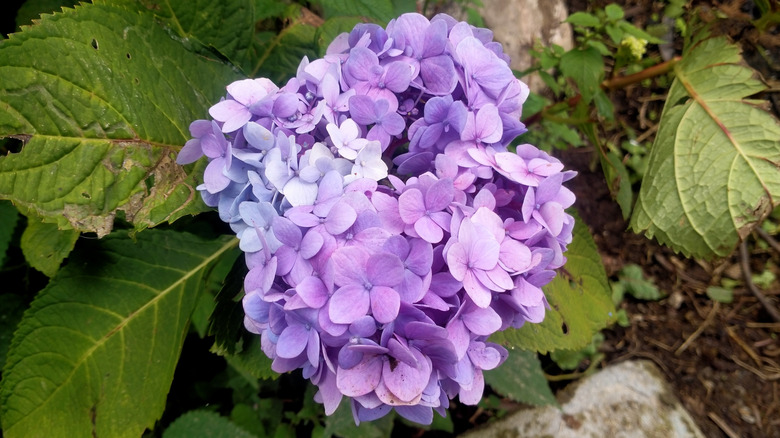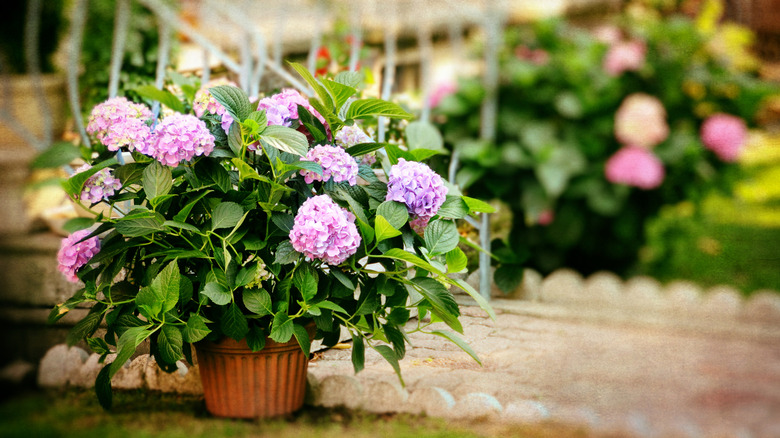The Worst Time To Plant Store-Bought Hydrangeas (& Why They're Likely To Die)
We may receive a commission on purchases made from links.
Hydrangeas are a popular deciduous flowering shrub due to their large, ornamental blooms. These large bushes can grow three to six feet tall, however, you've probably seen them mostly as smaller potted plants. These pastel-colored blooms seem the epitome of springtime and are often given as gifts for Easter or Mother's Day. You will also find slightly larger hydrangea plants in garden centers. These hydrangeas are typically the bigleaf variety (Hydrangea macrophylla) , and are intended for immediate replanting.
It can be hard to pass by a beautifully blooming hydrangea without wanting it for your own yard. But some self-restraint and a little patience could be the difference between enjoying your hydrangeas year after year or one fleeting summer. The fact is, if store-bought hydrangeas are already blooming, it is the worst possible time to plant them. These plants have been grown in a greenhouse and may have been forced to bloom early. While they will look healthy in the store, it may not be the right time of year for hydrangeas to bloom, and the greenhouse grown variety are not as winter hardy. Also, newly planted hydrangeas can take a couple of years to get acclimated to your yard's conditions before blooming, and it's best to give them the time they need.
For successful hydrangea blooms, purchase a bare root hydrangea and plant during the dormant season in early spring. These hydrangeas look almost completely dead and unappealing, but will produce longer-lasting blooms than the already-blooming variety come summer.
The best way to plant and care for hydrangeas
Before purchasing hydrangeas, make sure you have the right variety for your area. There are many types of hydrangea, and USDA hardiness zones can vary from 3 to 11 (most are hardy to USDA zone 6). When growing hydrangeas from seed, plant in the fall before the first frost. Fill a flat with potting soil and place seeds on top of — not into — the dirt. Protect the tiny seeds from wind and keep the soil moist. You should see small plants after around 2 weeks, which you can replant into your yard. It fairly difficult to grow hydrangeas from seeds, which is why a bare root hydrangea is best.
Plant your bare root hydrangea in the early spring (February or March). Hydrangeas tend to bloom in late June to early July, so this will give the plant time to establish roots before blooming. Choose a spot with morning sun and afternoon shade with well-draining soil. Use rich, non-sandy soil and fertilize or compost as necessary. Water thoroughly after planting and then regularly during the summer months, keeping the soil moist (water deeply a few times a week instead of shallow watering daily). Prune hydrangeas according to the care instructions for your specific type, and whether it blooms on old or new wood (for bigleaf hydrangeas, prune in late July as the blooms begin to fade).
How to plant and care for already-blooming hydrangeas
Blooming hydrangeas that you purchased or received as a gift in spring should be kept in a pot until June (their natural blooming time). Once purchased, immediately transplant the hydrangea into a larger pot, with around an inch of space on all sides. Make sure the pot is well-draining and your potting soil is aerated and not compact. Keep the pot in a sunny spot, but not too sunny (an Eastern-facing window is best). Potted gift hydrangeas have a much smaller chance of survival than the blooming garden-center variety, but successfully transplanting them is not impossible.
Remove dead roots before planting and choose a cooler time of day to transplant. Dig a hole as long as the root ball and insert the hydrangea. Cover half way with soil, water, then continue filling the hole. Since you are planting in the dead of summer instead of fall or spring, you need to make sure the hydrangea is watered very well, especially in the first few weeks.
Greenhouse hydrangeas are not very winter hardy, therefore you may need to prep your hydrangeas for winter before the first frost. Place a screen around the bush and fill it with insulation, such as SuperMoss Coco Mulch or peat moss. Remove in the spring, after the final frost.


